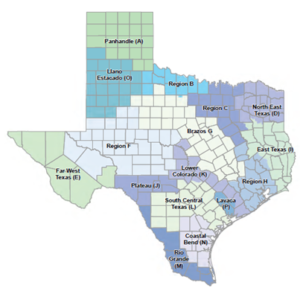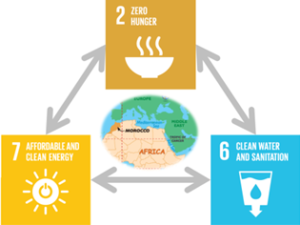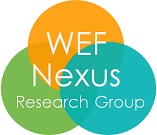Water-Energy-Food Nexus: Toward Sustainable Resource Management
on campus: BAEN 642 or CVEN 642 Distance Education: CVEN 642
A Water-Energy-Food Nexus graduate course has been developed and is now offered for the second time at Texas A&M University.
The course allows students to study the principles of the Water-Energy-Food interlinkages and their implications on the security and sustainability of Water-Energy-Food systems at the state, national and international levels. It provides foundations for quantifying and modeling the interactions between resource systems in order to assess sustainable tradeoffs of future resource allocation scenarios. Students learn in an experiential based environment, work on case studies and practical projects. Students are asked to develop customized holistic science-based assessment tools which help decision makers address specific challenges.
Upon completion, students will be able to describe global risks and nexus hotspots, to quantify the inter-linkages of the Water-Energy-Food systems, and to identify how engineering and analytics interface with economics, policy and supply chain at local and global scales.
The course is also available online, and includes a rich reading list. Lectures are in classroom, and through Camtasia and MediaMatrix. There are several renowned, international lectures who will offer lectures and participate in discussions via interactive web-based discussions.
Project Examples:
Addressing the Water Gap in Texas: A WEF Nexus Approach (Team: Kaushik, Blake, Zamaripa, Shafiezadeh , Askariyeh, Daher, Lee)
, Askariyeh, Daher, Lee)
Texas Development Water Board State Water Plan for 2012 anticipates that Texas will face a 40% water gap by 2060. This reflects an overall projection for the state, but the water gap will impact each of the 16 regional water planning zones of Texas differently, depending upon the specific population growth, water needs, and existing water supplies. Agricultural activity, energy development (particularly hydraulic fracturing), and urban growth will represent multiple competing demands for water. As a result of the great variability in resource distribution across the State, as well as the dynamic of competing demands, different hotspots with unique characteristics emerge. Successfully bridging the Texas water gap, as well as the similarly predicted gaps in locations around the globe, will depend upon our ability to adapt and adopt localized interventions that effectively respond to and address the particular local hotspot. Any assessment of projected trends, and understanding of potential impact of possible interventions must be holistic, yet localized, in order to capture the interconnections between the resource systems.
The Role of the WEF Nexus in Implementing Sustainable Development Goals in Morocco (Team: Daher, Hallmark and  Olayiwola)
Olayiwola)
In September 2015, member States of the United Nations committed to working towards a list of 17 Sustainable Development Goals (SDGs) by 2030. This study focuses on highlighting the interactions and potential competition that exists among the Water, Energy, and Food Goals (SDGs 2, 6, and 7). The State of Morocco will be used as a pilot demonstration case study. A quantitative methodology and tool which highlights trade-offs among different pathways associated with achieving a set of targets under the three goals will be presented.
Water-Energy-Food Tradeoffs for the Matagorda County (Team: Garibay and Yang)
The Mekong River is of great significance to the people of Southeast Asia and highly valued for its role in c ulture throughout history. The basins are seen as the engines behind energy infrastructure, regional transportation grids, and tourism development (Asian Development Bank’s Greater Mekong Sub-Region (GMS) initiatives). However, competing demand of water, energy and food, and threats posed by climate change, constrain the region’s future development. This study used the Resilience Index (RI), a tool to gauge the level of a country’s combined food water and energy securities, to analyze the effects of potential policy change scenarios of the individual countries in the Basin. It demonstrates the potential of the RI to assist policy makers in informed decision making. Treating water, food, and energy security as an integrated whole is crucial to the creation of an optimal strategy for future development.
ulture throughout history. The basins are seen as the engines behind energy infrastructure, regional transportation grids, and tourism development (Asian Development Bank’s Greater Mekong Sub-Region (GMS) initiatives). However, competing demand of water, energy and food, and threats posed by climate change, constrain the region’s future development. This study used the Resilience Index (RI), a tool to gauge the level of a country’s combined food water and energy securities, to analyze the effects of potential policy change scenarios of the individual countries in the Basin. It demonstrates the potential of the RI to assist policy makers in informed decision making. Treating water, food, and energy security as an integrated whole is crucial to the creation of an optimal strategy for future development.
Groundwater Pumping Projections for Energy and Agriculture: Energy-Water Nexus in South Texas (Team: Nata)
Hydraulic fracturing  (HF) is a water-energy hotspot for south-central Texas. While HF usually relies on fresh groundwater, its use for mining is a fraction of overall groundwater used in Texas as a whole, but the share and intensity is significant in some countries of south central Texas, intensifying the water-energy nexus. This may increase the tradeoff between types of groundwater used. Using Texas Water Development Board data, time series data for groundwater was collected from 2001-14. Two econometric models were used to estimate the irrigation and mining use, and see the extent of the tradeoffs between them.
(HF) is a water-energy hotspot for south-central Texas. While HF usually relies on fresh groundwater, its use for mining is a fraction of overall groundwater used in Texas as a whole, but the share and intensity is significant in some countries of south central Texas, intensifying the water-energy nexus. This may increase the tradeoff between types of groundwater used. Using Texas Water Development Board data, time series data for groundwater was collected from 2001-14. Two econometric models were used to estimate the irrigation and mining use, and see the extent of the tradeoffs between them.

 WEF Nexus Research Group
WEF Nexus Research Group